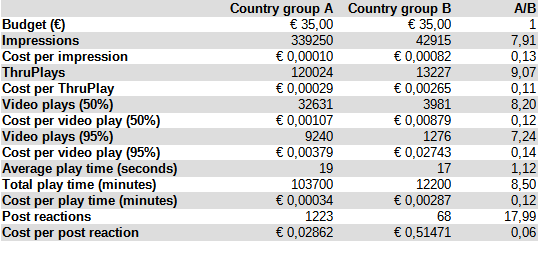Quick summary: The same ad performed 7x - 9x better in lower income countries, the meat consumption in these lower income countries is about 1/8th as high, which indicates promoting in lower income countries might have very comparable results in terms of how much it reduces meat consumption.
This is a short report on a test I ran to see if promoting Animal Rights content in low income countries is more effective/has a potentially higher impact than to promote it in high income countries.
To test this, I promoted this video: https://fb.watch/oqPsFPF0Ut/ in two groups of countries. (Thank you to Kinder World for allowing me to use their video for this test!)
Country group A: Angola, Ethiopia, Lesotho, Nigeria, Rwanda
Country group B: Australia, Canada, United Kingdom, New Zealand, United States
In both tests, I used a budget of 35€, the target group was all English speaking people 18 and older, and the ad goal was to maximize video views.
Here are the results:
A short explanation of terms:
Impressions – Number of time the ad was shown to a Facebook user.
Thru Plays – Number of time the video was played for at least 15 seconds.
Video plays (50%)/(95%) - Number of time the video was played at 50%/95% of its length (around 50 seconds / 1:34 minutes).
Post reactions: Total amount of reactions (like, love, sad etc.) to the video.
So overall, the ad performed around 7x – 9x as well in the lower income countries compared to the higher income countries.
If we compare this to the average meat consumption of the two country groups (based on https://en.wikipedia.org/wiki/List_of_countries_by_meat_consumption ) as a stand in for total animal product consumption:
Country group A: The lower income countries have a meat consumption between 5,4 kg (Ethiopia) and 23,5 kg (Angola) per person per year. The average between the 5 countries is 13,00 kg per person per year
Country group B: The higher income countries have a meat consumption between 79,9 kg (United Kingdom) and 124,11 kg (United States) per person per year. The average between the 5 countries is 101,83 kg per person per year.
Meaning the meat consumption in the higher income countries I ran this ad in is on average 7,83x higher than in the lower income countries.
Conclusion: If we assume people in both country groups are equally likely to reduce their meat consumption by an equal percentage after seeing this ad, both ads will have had a very comparable effect overall. Further testing would certainly be required to make any conclusions from this.
Notes:
- This was one very small test in a limited number of countries with a small budget, so of course these results are only meant to give a rough idea if focusing on lower income countries might be worthwhile.
- There is an almost unlimited number of variables that could be changed for an ad campaign like this and which would certainly influence the results. (Video chosen, countries the ad is run in, ad goal, target audiences etc.).
- For future testing, it might be a good idea to choose countries based on meat consumption divided by promotion cost (Find countries with very high consumption and low promotion cost).
Other limitations of this test include:
- It did not in any way measure if people actually reduce their meat consumption after seeing the video. (I think it is likely harder for people in lower income countries to remove animal products from their diets.)
- It only compared the results to meat consumption, not consumption of animal products overall.
- A video specifically tailored to lower income countries (showing the animal industry in those countries) might be more relevant to people there.
- The same video has been promoted in most of the higher income countries by Kinder World before, and I assume people in higher income countries are overall more likely to have seen Animal Rights content before (both of which might influence the results)
- More people in country group B speak English as a first language compared to country group A, people might be less willing to watch a video in a language that is not their first, which might have made the results in country group A worse.


Some great things about this post:
I'd love to see this exact experiment done on a larger scale with more robust outcome data. Kudos to the author. I hope they post more stuff like this.
Nice one I am from Nigeria and the results are true